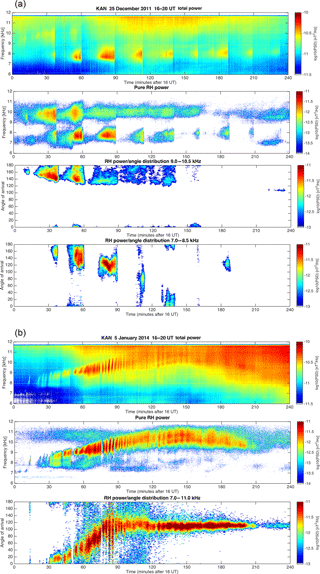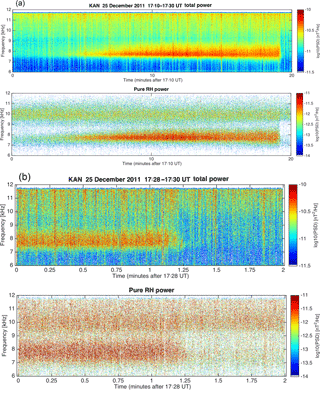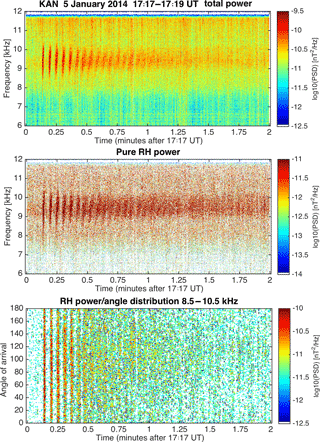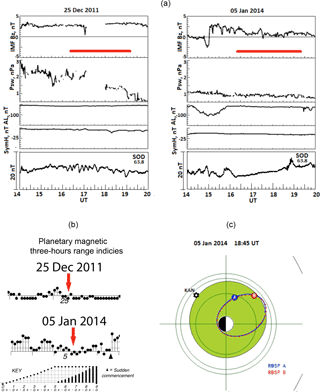the Creative Commons Attribution 4.0 License.
the Creative Commons Attribution 4.0 License.
New high-frequency (7–12 kHz) quasi-periodic VLF emissions observed on the ground at L ∼ 5.5
Natalia Kleimenova
Tauno Turunen
Liudmila Gromova
We reveal previously unknown quasi-periodic (QP) very low frequency (VLF) emissions at the unusually high-frequency band of ∼ 7–12 kHz by applying the digital filtering of strong atmospherics to the ground-based VLF data recorded at Kannuslehto station (KAN). It is located in northern Finland at L ∼ 5.5. The frequencies of QP emissions are much higher than the equatorial electron gyrofrequency at L ∼ 5.5. Thus, these emissions must have been generated at much lower L shells than KAN. Two high-frequency QP emission events have been studied in detail. The emissions were right-hand polarized waves indicating an overhead location of the exit area of waves in the ionosphere. In one event, the spectral–temporal forms of the emissions looked like a series of giant “bullets” due to the very abrupt cessation. Unfortunately, we could not explain such a strange dynamic spectral shape of the waves. In the second event, the modulation period was about 3 min under the absence of simultaneous geomagnetic pulsations. The studied emissions lasted about 4 h and were observed under the very quiet geomagnetic activity. The adequate mechanisms of the generation and propagation of the revealed high-frequency QP emissions have not yet been established. We speculate that studied QP emissions can be attributed to the auto-oscillations of the cyclotron instability in the magnetospheric plasma maser.
- Article
(12763 KB) - Full-text XML
- BibTeX
- EndNote
The whistler mode very low frequency (VLF) emissions, observed on the ground and onboard satellites, can exhibit a quasi-periodic (QP) occurrence of the separated signal patches in the frequency range of about 0.5–4 kHz, and due to that, they are termed QP emissions (e.g., Carson et al., 1965; Kitamura et al., 1969; Sato et al., 1974; Morrison et al., 1994; Sazhin and Hayakawa, 1994; Engebretson et al., 2004; Němec et al., 2016). QP emissions were measured by satellites over a large volume of geospace (e.g., Pasmanik et al., 2004; Němec et al., 2013, 2014; Titova et al., 2015; Hayosh et al., 2016). A series of expressive long-lasting QP emissions, observed at ground station at the auroral latitudes, have been shown by Manninen et al. (2012, 2013, 2014). Note that the ground-based recordings provide important information about the temporal properties of the studied waves.

Figure 1The 2 h spectrograms of QP events observed on 25 December 2011 and 5 January 2014. Panels (a) and (b) show 0–12 kHz spectrograms without sferics filtering, demonstrating that intense sferics hide all natural VLF emissions at frequencies above 4 kHz. Panels (c) and (d) show the same intervals after filtering out the sferics, and previously unknown events revealed. Color bars shown in the right side represent the signal power (in log10(PSD), in nT2 Hz−1).
However, even at auroral latitudes, the ground-based VLF measurements are mostly covered by strong atmospherics (sferics) (e.g., Yamashita, 1978; Yedemsky et al., 1992; Volland, 1995) which hide all natural emissions with weaker amplitudes. Tweek atmospherics are electromagnetic pulses with duration of ∼ 10–100 ms that originated from lightning discharges and propagate over distances of a few thousands of kilometers in the Earth–ionosphere waveguide (e.g., Ohya et al., 2015). To study the waves of the magnetospheric origin, we applied the special method of digitally filtering out the strong impulsive atmospherics with duration less than 30 ms. This processing allowed us to discover completely new types of high-frequency VLF emissions (Manninen et al., 2016). Besides separated discrete emissions, discussed by Manninen et al. (2016), we also found some previously unknown unusually high-frequency quasi-periodic VLF emissions lasting up to several hours. Such emissions have not been reported earlier.
The aim of this paper is to present the spectral feature of the revealed emissions at the frequency higher than 7 kHz. Our study was based on the VLF measurements (Manninen, 2005) at the auroral latitudes (L ∼ 5.5) in northern Finland at Kannuslehto (KAN, the geographic coordinates are 67.74∘ N, 26.27∘ E). To reject the influence of the strong narrow-band navigation transmitter signals, we analyzed the VLF emissions at the frequencies less than 12 kHz.

Figure 2(a) The 4 h VLF spectrograms at 6–12 kHz: total power (uppermost panel), right-handed power (second panel), the wave power/angle distribution based on pure right-hand power at 9.0–10.5 kHz (third panel) and 7.0–8.5 kHz (lowermost panel) on 25 December 2011. Color bars represent the signal power (in log10(PSD), in nT2 Hz−1). (b) The 4 h VLF spectrograms at 6–12 kHz: total power (uppermost panel), right-handed power (middle panel), the wave power/angle distribution based on pure right-hand power at 7.0–11.0 kHz (lowermost panel) on 5 January 2014.
Here we present the analysis of two events of the unusually high-frequency QP emissions observed on 25 December 2011 and 5 January 2014, both at 16:00–20:00 UT (19:00–23:00 MLT). The 2 h non-filtered spectrograms, shown in Fig. 1a–b, demonstrate that the strong sferics hide all other weaker waves at the frequencies higher than 5–6 kHz. The same spectrograms, obtained after filtering out sferics, are shown in Fig. 1c–d. Unexpectedly, after this filtering, the strange QP emissions were detected at the frequency band of about 7–12 kHz. A rather similar event was recorded also on 10 December 2012 (not studied here). All considered VLF emissions were the right-hand (RH) polarized waves, indicating the ionospheric exit point location to be approximately overhead. It is unlike the sferics, which were characterized by the left-hand polarization (e.g., Yedemsky et al., 1992; Haykawa et al., 1994). Some behavior of waves such as the temporal dynamics of the right-hand polarized part of the QP missions and its arriving direction of both studied events are given in Fig. 2 in the 6–12 kHz frequency band.
Description of the VLF receiver is given by Manninen (2005). Sampling frequency was 78 125 Hz and the noise level of the receiver is 10−14 nT2 Hz−1. The fast Fourier transform (FFT) size is 8192 in all spectral analysis.
2.1 Event of 25 December 2011
The spectrogram of the first studied event (25 December 2011, Fig. 1a and c) demonstrates the strange spectral–temporal forms look like a chain of giant “bullets” with a very sharp end on each element. The 4 h total power spectrogram of this event as well as the right-hand polarized power of the waves in frequency band of 6–12 kHz and the angles of arrival of the waves are given in Fig. 2a. It is seen that the RH polarized waves represented two separated frequency bands: the strongly modulated band of 7.0–8.5 kHz and almost continuous hiss-like band of 9.0–10.5 kHz. Two strong bullets are observed in the beginning of the high-frequency band. It is interesting to note that the first bullet occurred at the higher frequency band, the second bullet appeared at both frequency bands and later the bullets were observed only at the lower frequencies. That could be interpreted as a result of a time shift of the wave generation region to higher L shells.

Figure 3(a) The 6–12 kHz VLF spectrograms (total and right-handed powers) of one individual element (“bullet”) of QP emissions at 17:10–17:30 UT on 25 December 2011. (b) Same event as in Fig. 3a., but only lasting 2 min (17:28–17:30 UT).

Figure 4The 6–12 kHz VLF spectrograms (total and right-handed powers) and the variation of the integrated wave intensity in the 8–11 kHz frequency band on 5 January 2014.

Figure 5The 6–12 kHz VLF spectrograms (total and right-handed powers) of 2 min duration and the wave power/angle distribution based on pure right-hand power at 8.5–10.5 kHz of the short-period QP emissions on 5 January 2014.

Figure 6Geophysical situation during two considered events: (a) OMNI data (IMF Bz and Psw), the AL and SymH geomagnetic indexes, and the magnetograms from SOD; (b) the variation of the planetary Kp index; (c) the plasmapause location according to measurements on satellites RBSP (A and B) (available at: http://enarc.space.swri.edu/PTP; last access: 5 April 2018).
The direction-finding analysis showed that the high-frequency band arrived mostly along the meridian during the whole event, but the angles of arrival of the low-frequency `bullets” changed with time, deviating from the meridian (Fig. 2a, two lower panels). The angle of arrival has an uncertainty of 180∘ (or ambiguity) due to the fact that only two orthogonal magnetic loop antennas oriented in the north–south and east–west directions are used in this study. The angle of arrival is determined as the direction of the minor axes of the wave polarization ellipses. In order to remove the ambiguity, an additional vertical electric antenna would be needed.
Attributing the emission generation to the electron cyclotron instability (e.g., Trakhtengerts and Rycroft, 2008), we may suppose the different location of the generation regions responsible for the high-frequency hiss and for the bullet. The higher frequency band originated at the smaller L shells than the lower frequency band, and, the source of the bullet-like emissions removed in course of time. Although these two bands may have different source locations, the sharp ends of every burst occur simultaneously in all frequencies.
The spectrogram of one separated bullet is presented in Fig. 3 in both 20 min (Fig. 3a) and 2 min (Fig. 3b) timescales. A totally new observation was a very abrupt cessation of the bullet, which is clearly seen in Fig. 3a near 17:29 UT. It is very steep in the timescale of several seconds (Fig. 3b). It is important to note that there were no such remarkable changes in the higher frequency (9.0–10.5 kHz) band. This suggests that the end of the emission is not a consequence of the filtering method. Unfortunately, we could not find a plausible source of such strong signal rejection. Some speculation could be attributed to a sudden drop of the flux of trapped electrons at the geomagnetic flux tube, where the wave-particle interaction is taking place.
2.2 Event of 5 January 2014
The second studied event (5 January 2014, Fig. 1b and d) represents a series of quasi-repeated short patches with rather constant low frequencies and gradually increasing upper ones. The analysis of this QP event (Fig. 2b) demonstrated that the behavior of the event is much more visible in the RH wave power spectrum than in its total power spectrum (upper plot). During first 2 h, the band of emissions gradually shifted to the higher frequencies. At the beginning, the upper frequency limit increased from ∼ 9 to ∼ 11 kHz within 1.5 h. After ∼ 18:30 UT, it began to decrease down to ∼ 10 kHz (at ∼ 19:30 UT). As well as during the 25 December 2011 QP event (Fig. 2a), the angle of arrival of this QP event quickly changed, deviating from the north–south direction. At about 17:30 UT, the angle of arrival got settled approximately along the east–west direction, as if in a daily rotation of the Earth the receiver is removed away from the source of wave generation. Note that, at this time, the waves remained RH polarized, so we may conclude that, all this time, the VLF receiver was located not very far from the ionospheric exit area of waves.
The detailed structure of the quasi-repeated patches is shown in Fig. 4 as the temporal variation of total (T) and right-handed wave power spectra. The bottom panel represents the variations of the integrated wave intensity in the frequency band of 7–10 kHz, demonstrating the average period of the VLF wave repetition of ∼ 3 min. In addition, there were altogether 10 QP emission bursts with 3 s internal periodicity shown in the bottom panel in Fig. 4. According to ground-based measurements with a Scandinavian IMAGE magnetometer chain, there were no geomagnetic pulsations with similar periods.
Besides this 3 min periodicity, Fig. 4 demonstrates an appearance of the strong impulsive packets of VLF emissions with very short repetition periods superposing the quasi-repeated VLF patches. An example of the fine structure of these impulses is shown in Fig. 5 at a 2 min timescale. It was found that its structure consists of the long series of the RH polarized QP emissions in the ∼ 8.5–10.5 kHz frequency band with a repetition period of about 3 s. The first six emissions were non-dispersive, but the following ones exhibited smaller intensity, decreasing with time and positive time–frequency slope (df/dt > 0). The short-term QP emissions having similar periodicity has been recorded previously on the ground and onboard satellites (e.g., Bespalov et al., 2010; Manninen et al., 2014). However, in these papers the QP emissions were at the frequencies less than 2.5 kHz, but in our case the QP emissions were observed at frequencies higher than 7 kHz.
During our events, the conditions in the solar wind and IMF were very quiet, shown in Fig. 6a. During the studied intervals, there were no geomagnetic disturbances and pulsations at Sodankylä (SOD), located 45 km south-east from KAN. The planetary geomagnetic activity was quiet with Kp ∼ 0. However, some small Kp enhancements can be seen within the preceding 24 h (Fig. 6b), providing additional electrons in the radiation belts. This might be due to a small magnetic substorm in the night side (AL values up to 100 nT) before the 5 January 2014 event. There was no substorm before 25 December 2011 event. According to data of RBSP (A and B) satellites (http://enarc.space.swri.edu/PTP; last access: 5 April 2018), KAN was mapped in the vicinity of the plasmapause (Fig. 6c).
There is no complete theory adequately explaining the generation of such high-frequency QP emissions because our finding is so new. The studied QP events were not accompanied by ULF magnetic pulsations with any period comparable to the modulation period of QP emissions. So, a possible generation mechanism of such a QP event could be the periodic wave generation in the relaxation oscillations of the cyclotron instability of the Earth radiation belts in the magnetospheric plasma maser (Bespalov and Trakhtengerts, 1986; Trakhtengerts and Rycroft, 2008). This model was also applied to explain some satellite observations of QP emissions (Pasmanik et al., 2004). The excitation of these oscillations is possible only during low geomagnetic activity, as was observed during the studied events.
The revealed 7–10 kHz QP emissions could not be generated at L shell corresponding to KAN location because the equatorial electron gyrofrequency at L ∼ 5.5 is ∼ 5 kHz, and this value controls the upper frequency of the generation of whistler mode waves at given L shell. Moreover, the ducted propagation of the whistler mode wave in the magnetosphere is possible only at frequencies less than one-half of this value (Carpenter, 1968). So, we suppose that the studied QP emissions propagated in unducted mode, as was discussed in previous papers (Němec et al., 2013; Titova et al., 2015; Hayosh et al., 2016). We assume that the high-frequency QP emissions are generated at much lower L shells than KAN, probably even inside of the plasmasphere.
Applying the digital filtering of strong sferics to the ground-based VLF data at L ∼ 5.5 we reveal previously unknown quasi-periodic VLF emissions at unusually high frequencies of ∼ 7–11 kHz. These frequencies are much higher than the equatorial gyrofrequency of electrons at L ∼ 5.5.
Contrary to typical QP emissions, the discovered high-frequency waves, presented in this paper, were observed in the late evening. The emissions were right-hand polarized, indicating that the ionospheric exit point of the waves was located approximately overheard. In the first event, the spectral–temporal forms of the emissions looked like a series of giant “bullets” due to the very abrupt cessation. There were no geomagnetic or absorption events, which could explain the sharp stop in the generation of the bullets on 25 December 2011. Maximum variation in geomagnetic field was only 4 nT and riometer absorption was at the background level. Unfortunately, we could not explain such strange features of the emissions. In the second event, the repetition period was about 3 min, with the absence of the simultaneous geomagnetic pulsations. Thus, the source of such modulation remains unknown.
The high-frequency QP emissions were observed under very quiet geomagnetic activity. Apparently, the studied emissions can be attributed to the auto-oscillations of the cyclotron instability in the magnetospheric plasma maser (Bespalov and Trakhtengerts, 1986; Trakhtengerts and Rycroft, 2008), and we speculate that the studied waves propagated in the unducted mode. The source of studied QP emissions could be located at low L values in the plasmasphere. However, the adequate mechanism of the generation and propagation of QP emissions at untypically high frequencies is not yet established.
Quick-look plots of Kannuslehto VLF data are available at http://www.sgo.fi/pub_vlf/. Detailed plots must be requested from jyrki.manninen@sgo.fi. Sodankylä magnetic data plots are available at http://www.sgo.fi/Data/Magnetometer/magnData.php (last access: 5 April 2018). The requests for other data products can be sent via this web page: http://www.sgo.fi/Contact/ContactUs.php (last access: 5 April 2018). Contact person is tero.raita@sgo.fi.
The authors declare that they have no conflict of interest.
The research was supported by the Academy of Finland (grant no. 287988)
during the stays of Natalia Kleimenova and Liudmila Gromova in Sodankylä. The
work by Natalia Kleimenova was partly supported by the Program of Presidium
of Russian Academy of Science no. 28.
The topical editor, Yoshizumi Miyoshi, thanks Michael J.
Rycroft and one anonymous referee for help in evaluating this paper.
Bespalov, P. A. and Trakhtengerts, V. Yu.: The cyclotron instability in the Earth radiation belts, Rev. Plasma Physics, Plenum Publ. NY, edited by: Leontovich, M. A., 10, 155–292, 1986.
Bespalov, P. A., Parrot, M., and Manninen, J.: Short period VLF emissions as solitary envelope waves in a magnetospheric plasma maser, J. Atmos. Sol.-Terr. Phy., 72, 1275–1281, 2010.
Carpenter, D. L.: Ducted whistler-mode propagation in the magnetosphere; a half-gyrofrequency upper intensity cut-off and some associated wave growth phenomena, J. Geophys. Res., 73, 2919–2928. 1968.
Carson, W. B., Koch, J. A., Pope, J. H., and Gallet, R. M.: Long-period very low frequency emission pulsations, J. Geophys. Res., 70, 4293–4303, 1965.
Engebretson, M. J., Posch, J. L., Halford, A. J., Shelburne, G. A., Smith, A. J., Spasojevic, M., Inan, U. S., and Arnoldy, R. L.: Latitudinal and seasonal variations of quasiperiodic and periodic VLF emissions in the outer magnetosphere, J. Geophys. Res., 109, A05216, https://doi.org/10.1029/2003JA010335, 2004.
Hayakawa, M., Ohta, K., and Baba, K.: Wave characteristics of tweek atmospherics deduced from the direction-finding measurement and theoretical interpretation, J. Geophys. Res., 99, 10733–10743, 1994.
Hayosh, M., Němec, F., Santolik, O., and Parrot, M.: Propagation properties of quasi-periodic VLF emissions observed by the DEMETER spacecraft, J. Geophys. Res.-Space, 43, 1007–1014, https://doi.org/10.1002/2015GL067373, 2016.
Kitamura, T., Jacobs, J. A., Watanabe, T., and Flint, J. R. B.: An investigation of quasi-periodic VLF emissions, J. Geophys. Res., 74, 5652–5664, 1969.
Manninen, J.: Some aspects of ELF–VLF emissions in geophysical research, Sodankylä Geophys. Obs. Publ. no. 98, Oulu Univ., Finland, available at: http://www.sgo.fi/Publications/SGO/thesis/ManninenJyrki.pdf (last access: 5 April 2018), 2005.
Manninen, J., Kleimenova, N. G., and Kozyreva, O. V.: New type of ensemble of quasi-periodic, long-lasting VLF emissions at the auroral zone, Ann. Geophys., 30, 1655–1660, https://doi.org/10.5194/angeo-30-1655-2012, 2012.
Manninen J., Kleimenova, N. G., Kozyreva, O. V., Bespalov, P. A., and Kozlovsky, A. E.: Non-typical ground-based quasi-periodic VLF emissions observed at L ∼ 5.3 under quiet geomagnetic conditions at night, J. Atmos. Sol.-Terr. Phy., 99, 123–128, 2013.
Manninen, J., Demekhov, A. G., Titova, E. E., Kozlovsky, A. E., and Pasmanik, D. L.: Quasi-periodic VLF emissions with short-period modulation and their relationship to whistlers: A case study, J. Geophys. Res.-Space, 119, 3544–3557, https://doi.org/10.1002/2013JA019743, 2014.
Manninen, J., Turunen, T., Kleimenova, N., Rycroft, M., Gromova, L., and Sirvio, I.: Unusually high frequency natural VLF radio emissions observed during daytime in Northern Finland, Environ. Res. Lett. 11, 124006, https://doi.org/10.1088/1748-9326/11/12/124006, 2016.
Morrison, K., Engebretson, M. J., Beck, J. R., Johnson, J. E., Arnoldy, R. L., Cahill Jr., L. J., Carpenter, D. L., and Gallani, M.: A study of quasi-periodic ELF–VLF emissions at three Antarctic stations: evidence for off-equatorial generation?, Ann. Geophys., 12, 139–146, https://doi.org/10.1007/s00585-994-0139-8, 1994.
Němec, F., Santolik, O., Parrot, M., Pickett, J. S., Hayosh, M., and Cornilleau-Wehrlin, N.: Conjugate observations of quasi-periodic emissions by Cluster and DEMETER spacecraft, J. Geophys. Res.-Space, 118, 198–208, https://doi.org/10.1029/2012JA018380, 2013.
Němec, F., Pickett, J. S., and Santolik, O.: Multispacecraft Cluster observations of quasiperiodic emissions close to the geomagnetic equator, J. Geophys. Res.-Space, 119, 9101–9112, https://doi.org/10.1002/2014JA020321, 2014.
Němec, F., Bezděkova, B., Manninen, J., Parrot, M., Santolik, O., Hayosh, M., and Turunen, T.: Conjugate observations of a remarkable quasiperiodic event by the low-altitude DEMETER spacecraft and ground-based instruments, J. Geophys. Res.-Space, 121, 8790–8803, https://doi.org/10.1002/2016JA022968, 2016.
Ohya, H., Shiokawa, K., and Miyoshi, Y.: Daytime tweek atmospherics, J. Geophys. Res.-Space, 120, 654–665, https://doi.org/10.1002/2014JA020375, 2015.
Pasmanik, D. L., Titova, E. E., Demekhov, A. G., Trakhtengerts, V. Y., Santolik, O., Jiricek, F., Kudela, K., and Parrot, M.: Quasi-periodic ELF/VLF wave emissions in the Earth's magnetosphere: comparison of satellite observations and modeling, Ann. Geophys., 22, 4351–4361, https://doi.org/10.5194/angeo-22-4351-2004, 2004.
Sato, N., Hayashi, K., Kokubun, S., Oguti, T., and Fukunishi, H.: Relationships between quasi-periodic VLF emission and geomagnetic pulsation, J. Atmos. Terr. Phys., 36, 1515–1526, 1974.
Sazhin S. and Hayakawa, M.: Periodic and quasiperiodic VLF emissions, J. Geophys. Res., 56, 735–753, 1994.
Titova, E. E., Kozelov, B. V., Demekhov, A. G., Manninen, J., Santolik, O., Kletzing, C. A., and Reeves, G.: Identification of the source of quasiperiodic VLF emissions using ground-based and Van Allen probes satellite observations, Geophys. Res. Lett., 42, 6137–6145, https://doi.org/10.1002/2015GL064911, 2015.
Trakhtengerts, V. Yu. and Rycroft, M. J.: Whistler and Alfven Mode Cyclotron Masers in Space, Cambridge University Press, 354 pp., 2008.
Volland, H.: Longwave sferics propagation within the atmospheric waveguide, Handbook of Atmospheric Electrodynamics, edited by: Volland, H., Baton Rouge-London-Tokyo: CRC Press Roca, 2, 65–93,1995
Yamashita, M.: Propagation of tweek atmospherics, J. Atmos. Terr. Phys., 40, 151–156, 1978.
Yedemsky, D. E., Riabov, B. S., Shchekotov, A. I., and Yarotsky, V. S.: Experimental investigation of the tweek field structure, Adv. Space Res., 12, 251–254, 1992.
bullets, with very abrupt cessation. In the second event, the modulation period was about 3 min under the absence of the simultaneous geomagnetic pulsations.





